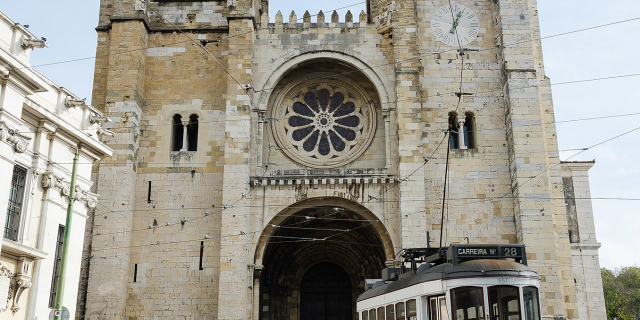Elevador da Bica
( Ascensor da Bica )The Bica Funicular (Portuguese: Ascensor da Bica), sometimes known as the Elevador da Bica (Bica Lift), is a funicular railway line in the civil parish of Misericórdia, in the municipality of Lisbon, Portugal. It connects the Rua de São Paulo with Calçada do Combro/Rua do Loreto, operated by Carris.
The line conforms to the funicular principle, with two cars permanently attached to opposite ends of a haulage cable, which is looped over a pulley at the upper end of the track. Unusually, traction is provided by electric motors on the two cars, which are themselves powered through an overhead wire. The cable links the two cars together so that they ascend and descend simultaneously, each car acting as a counterweight for the other one.
 A view of the funicular car at the top stop (in 1909)
A view of the funicular car at the top stop (in 1909) A view of the incline between Rua da Bica de Duarte Belo and Rua de São Paulo
A view of the incline between Rua da Bica de Duarte Belo and Rua de São PauloIn 1888, the municipality of Lisbon celebrated a contract with the Nova Companhia dos Ascensores de Lisboa providing them a concession to the installation of a lift system that connected the Rua da Bica de Duarte Belo to the Rua de São Paulo along the Largo do Calhariz.[1][2] The project was conceived by Raoul Mesnier du Ponsard.[1][2] The mechanical motor of the elevator was installed in 1890, after the conclusion of the public work. However, the lift only began functioning on 28 June 1892, after a couple of years of tests.[1]
In 1912, the Nova Companhia dos Ascensores Mecânicos de Lisboa signed a new contract with the municipality, allowing it to expand the electrification of all the lines.[1] Between 1914 and 1916, the project to automate the transport system using electrical systems was completed.[1] Unfortunately, during the conclusions of the process there was an accident with one of the cars, which became uncontrollable and crashed into the Rua de São Paulo lower station, resulting in its complete destruction.[1] As a result, the funicular transport became inoperable for the next few years.
In 1923, the municipal council demanded that company return the Bica lift to operation, forcing it to work on the line and install new cars, provided by the firm of Theodore Bell.[1] After the dissolution of the Nova Companhia dos Ascensores Mecânicos de Lisboa the lift became the property of Companhia Carris (or, simply, Carris). In 1927, the funicular returned to operation.[1]
On 29 September 2005, it was proposed that the funicular be included in the Special Protection Zone by the DRCLVTejo.[1] In 2009 the dispatch was approved by the Minister of Culture, and on 20 May 2011, the declaration was ratified that classified the lift with the architectural protection zone (Diário da República, 874/2011, Série-2, 98).[1]
On 10 January 2022, the funicular closed for approximately six months for conservation and restoration work.[3]




































Add new comment